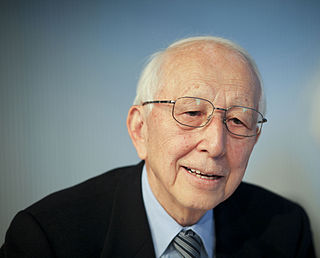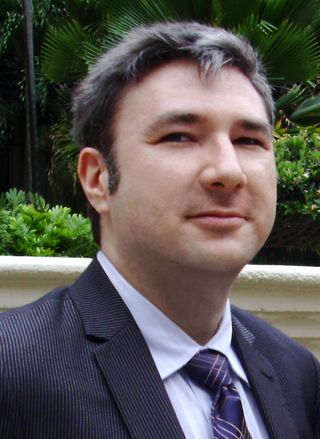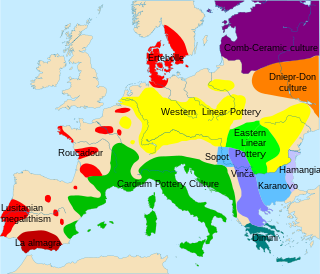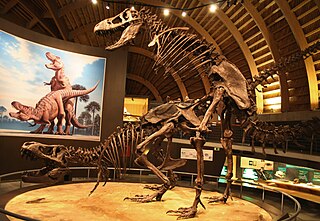Related Research Articles

A workflow is a generic term for orchestrated and repeatable patterns of activity, enabled by the systematic organization of resources into processes that transform materials, provide services, or process information. It can be depicted as a sequence of operations, the work of a person or group, the work of an organization of staff, or one or more simple or complex mechanisms.
An information society is a society where the usage, creation, distribution, manipulation and integration of information is a significant activity. Its main drivers are information and communication technologies, which have resulted in rapid growth of a variety of forms of information. Proponents of this theory posit that these technologies are impacting most important forms of social organization, including education, economy, health, government, warfare, and levels of democracy. The people who are able to partake in this form of society are sometimes called either computer users or even digital citizens, defined by K. Mossberger as “Those who use the Internet regularly and effectively”. This is one of many dozen internet terms that have been identified to suggest that humans are entering a new and different phase of society.

Postmodern art is a body of art movements that sought to contradict some aspects of modernism or some aspects that emerged or developed in its aftermath. In general, movements such as intermedia, installation art, conceptual art and multimedia, particularly involving video are described as postmodern.

A skeuomorph is a derivative object that retains ornamental design cues (attributes) from structures that were necessary in the original. Skeuomorphs are typically used to make something new feel familiar in an effort to speed understanding and acclimation. They employ elements that, while essential to the original object, serve no pragmatic purpose in the new system. Examples include pottery embellished with imitation rivets reminiscent of similar pots made of metal and a software calendar that imitates the appearance of binding on a paper desk calendar.
Scenography is a practice of crafting stage environments or atmospheres. In the contemporary English usage, scenography can be defined as the combination of technological and material stagecrafts to represent, enact, and produce a sense of place in performance. While inclusive of the techniques of scenic design and set design, scenography is a holistic approach to the study and practice of all aspects of design in performance.

In the arts, bricolage is the construction or creation of a work from a diverse range of things that happen to be available, or a work constructed using mixed media.

In art and design, negative space is the empty space around and between the subject(s) of an image. Negative space may be most evident when the space around a subject, not the subject itself, forms an interesting or artistically relevant shape, and such space occasionally is used to artistic effect as the "real" subject of an image.

Fumihiko Maki is a Japanese architect who teaches at Keio University SFC. In 1993, he received the Pritzker Prize for his work, which often explores pioneering uses of new materials and fuses the cultures of east and west.

Michael Betancourt is a critical theorist, film theorist, art & film historian, and animator. His principal published works focus on the critique of digital capitalism, motion graphics, visual music, new media art, theory, and formalist study of motion pictures.
Virtual heritage or cultural heritage and technology is the body of works dealing with information and communication technologies and their application to cultural heritage, such as virtual archaeology. It aims to restore ancient cultures as real (virtual) environments where users can immerse.
A virtual artifact (VA) is an immaterial object that exists in the human mind or in a digital environment, for example the Internet, intranet, virtual reality, cyberspace, etc.

The Karanovo culture is a Neolithic culture named after the Bulgarian village of Karanovo. The culture, which is part of the Danube civilization, is considered the largest and most important of the Azmak River Valley agrarian settlements.

Digital architecture refers to aspects of architecture that feature digital technologies or considers digital platforms as online spaces. The emerging field of digital architectures therefore applies to both classic architecture as well as the emerging study of social media technologies.
In Mediterranean architecture, the fina is a physical space used in urban design, corresponding to the approximately 1-meter-wide public space alongside buildings. It is used to describe the placement of design items within traditional architectural elements. It also mandates public rules of behaviour for the neighbours concerning the usage and maintenance of finas in their buildings. For instance, a person has the right to use the part of the fina immediately in front of his home for the loading or unloading of his vehicle but he has no right to block it.

Exhibit design is the process of developing an exhibit—from a concept through to a physical, three-dimensional exhibition. It is a continually evolving field, drawing on innovative, creative, and practical solutions to the challenge of developing communicative environments that 'tell a story' in a three-dimensional space.

The arts are a very wide range of human practices of creative expression, storytelling, and cultural participation. They encompass multiple diverse and plural modes of thinking, doing, and being, in an extremely broad range of media. Both highly dynamic and a characteristically constant feature of human life, they have developed into innovative, stylized, and sometimes intricate forms. This is often achieved through sustained and deliberate study, training, and/or theorizing within a particular tradition, across generations, and even between civilizations. The arts are a vehicle through which human beings cultivate distinct social, cultural, and individual identities while transmitting values, impressions, judgements, ideas, visions, spiritual meanings, patterns of life, and experiences across time and space.

In 3D computer graphics, 3D modeling is the process of developing a mathematical coordinate-based representation of any surface of an object in three dimensions via specialized software by manipulating edges, vertices, and polygons in a simulated 3D space.
Digital heritage is the use of digital media in the service of understanding and preserving cultural or natural heritage.
A digital twin is a digital model of an intended or actual real-world physical product, system, or process that serves as the effectively indistinguishable digital counterpart of it for practical purposes, such as simulation, integration, testing, monitoring, and maintenance. The digital twin has been intended from its initial introduction to be the underlying premise for Product Lifecycle Management and exists throughout the entire lifecycle of the physical entity it represents. Since information is granular, the digital twin representation is determined by the value-based use cases it is created to implement. The digital twin can and does often exist before there is a physical entity. The use of a digital twin in the creation phase allows the intended entity's entire lifecycle to be modeled and simulated. A digital twin of an existing entity may be used in real-time and regularly synchronized with the corresponding physical system.
Oku (奥) is a spatial theory or concept that pertains to the idea of "inwardness". It is unique to Japan and is an integral part of the urban space formation in the country. The term entails several abstract connotations such as profundity and can be used to describe not only physical but also psychological depth.
References
- 1 2 Harvey, Penny; Casella, Eleanor Conlin; Evans, Gillian; Knox, Hannah; McLean, Christine; Silva, Elizabeth B.; Thoburn, Nicholas; Woodward, Kath (2014). Objects and Materials: A Routledge Companion. Oxon: Routledge. p. 81. ISBN 9780415678803.
- ↑ Loschke, Sandra Karina (2016). Materiality and Architecture. Oxon: Routledge. pp. i. ISBN 9781138840645.
- ↑ Leonardi, Paul M.; Nardi, Bonnie A.; Kallinikos, Jannis (2012). Materiality and Organizing: Social Interaction in a Technological World. Oxford: Oxford University Press. p. 277. ISBN 978-0-19-966405-4.
- ↑ Kanaani, Mitra; Kopec, Dak (2015). The Routledge Companion for Architecture Design and Practice: Established and Emerging Trends. Oxon: Routledge. ISBN 978-1-317-68874-7.
- 1 2 Schröpfer, Thomas (2012). Material Design: Informing Architecture by Materiality. Basel: Walter de Gruyter. p. 8. ISBN 978-3-0346-0035-4.
- ↑ Carpo, Mario (2013). The Digital Turn in Architecture 1992 - 2012. Hoboken, NJ: John Wiley & Sons. p. 237. ISBN 978-1-118-42591-6.
- 1 2 Pink, Sarah; Ardèvol, Elisenda; Lanzeni, Dèbora (2016). Digital Materialities: Design and Anthropology. London: Bloomsbury Publishing. p. 7. ISBN 978-1-4725-9257-6.
- ↑ Janson, Alban; Tigges, Florian (2014). Fundamental Concepts of Architecture: The Vocabulary of Spatial Situations. Basel: Birkhauser. p. 189. ISBN 978-3-0346-0892-3.
- ↑ Crysler, C. Greig; Cairns, Stephen; Heynen, Hilde (2012). The SAGE Handbook of Architectural Theory. Thousand Oaks, CA: SAGE. p. 96. ISBN 978-1-4129-4613-1.
- ↑ Buchli, Victor (2013). An Anthropology of Architecture. London: Bloomsbury. p. 179. ISBN 978-0-85785-300-4.
- ↑ Brown, Lori A. (2013). Feminist Practices: Interdisciplinary Approaches to Women in Architecture. Farnham, UK: Ashgate Publishing, Ltd. ISBN 978-1-4094-8267-3.
- ↑ Lombaerde, Piet (2010). Bringing the World Into Culture: Comparative Methodologies in Architecture, Art, Design and Science. Asp / Vubpress / University Press Antwerp. p. 152. ISBN 978-90-5487-630-4.
- 1 2 Friedberg, Anne (2009). The Virtual Window: From Alberti to Microsoft. Cambridge, MA: MIT Press. p. 174. ISBN 978-0-262-06252-7.
- ↑ Bernardi, Joanne; Usai, Paolo Cherchi; Williams, Tami; Yumibe, Joshua (2021). Provenance and Early Cinema. Bloomington, Indiana: Indiana University Press. p. 320. ISBN 978-0-253-05299-5.
- Medway, P. (1996). "Virtual and Material Buildings: Construction and Constructivism in Architecture". Written Communication13(4):473-514
- Macarthur, J. (2002). "The Image As an Architectural Material". The South Atlantic Quarterly101(3)
- Rübel, D., Wagner, M., Wolff, V. (2005). "Materialästhetik. Quellentexte zu Kunst, Design und Architektur", Berlin
- Hill, J. (2006). "Drawing Forth Immaterial Architecture". Architectural Research Quarterly, Cambridge University Press, 10:51-55
- Zarzycki, A. (2006). "Light, materiality and narrative: beyond form-making in architecture". SESSION, Boston, Massachusetts, Article No. 20